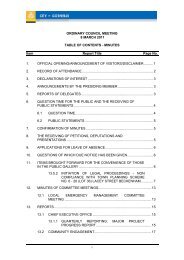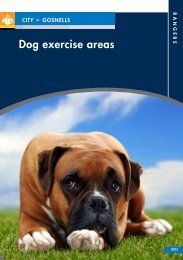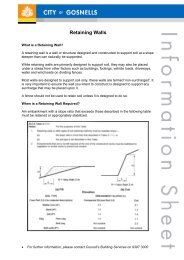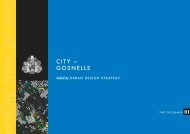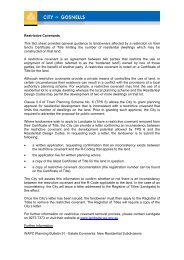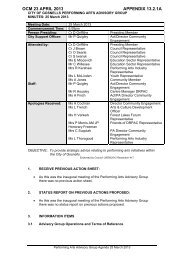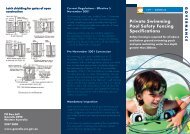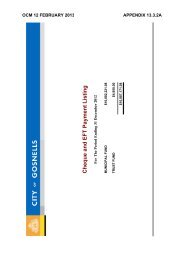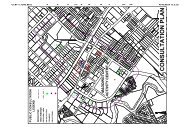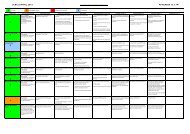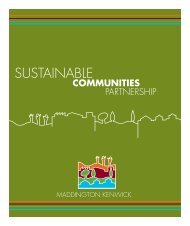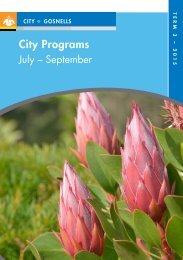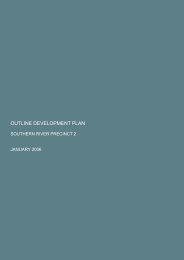Summary - City of Gosnells
Summary - City of Gosnells
Summary - City of Gosnells
Create successful ePaper yourself
Turn your PDF publications into a flip-book with our unique Google optimized e-Paper software.
Flora 37lanceolata, Schoenus andrewsii, Stylidium dichotomum, Stylidium divaricatum, Stylidium ecorne, Stylidiumutricularioides, Tribonanthes brachypetala, Tricoryne humilis, Tremulina tremula (syn. Restio tremulus),Verticordia acerosa and Verticordia plumosa.However, Government <strong>of</strong> Western Australian (2000) identified over 60 taxa that occur in the Foothills andPinjarra Plain (in the Perth Metropolitan Area) as having regional significance. Over 40 <strong>of</strong> these taxa areknown to occur in the Greater Brixton Street Wetlands. Apart from a number <strong>of</strong> taxa in the Keighery andTrudgen (1992) list, the following taxa were also included as species <strong>of</strong> regional significance on the easternSCP in Government <strong>of</strong> Western Australia (2000): Caesia micrantha Large Swamp Form (B.J. Keighery &N. Gibson 094), Calandrinia sp. Kenwick (aff. composita; G.J. Keighery 10905, Conospermum huegelii,Conospermum incurvum, Conospermum triplinervium, Cyathochaeta equitans, Cyclosorus interruptus,Darwinia sp. Muchea (B.J. Keighery 2006), Dasypogon obliquifolius, Dielsia stenostachya, Droserabulbigena, Drosera gigantea subsp. geniculata, Drosera macrantha Swan Coastal Plain form (B.J. Keighery& N. Gibson 228), Dryandra kippistiana, Dysphania glomulifera subsp. glomulifera, Epaltes australis,Eremaea purpurea, Eucalyptus lanepoolei, Glischrocaryon aureum, Grevillea alth<strong>of</strong>erum, Grevilleaobtusifolia, Hakea conchifolia, Hakea myrtoides, Hakea aff. lasiantha, Haloragis cordiger, Jacksoniagracilis, Johnsonia pubescens subsp. cygnorum, Kennedia coccinea, Isopogon asper, Kunzea aff. recurva(G.J. Keighery 12828), Melaleuca brevifolia, Pimelea imbricata var. major, Stylidium roseoalatum andStylidium utricularioides.In the current desktop survey, taxa listed as occurring in the Greater Brixton St Wetlands (Keighery andKeighery, 2000; Western Australian Herbarium, 2007, 2008, 2009) the Clifford St bushland (Government <strong>of</strong>Western Australia, 2000) or the Wattle Grove-Kenwick-Maddington area (Western Australian Herbarium,2007, 2008, 2009) and considered as regionally significant in studies <strong>of</strong> the eastern Swan Coastal Plain(including Keighery and Trudgen, 1992; Gibson et al., 1994; Keighery and Keighery, 2000; Government <strong>of</strong>Western Australia, 2000; Tauss, 2007a, 2009; Keighery and Tauss, 2008) were reviewed against their currentdistributions as given in FloraBase (Western Australian Herbarium, 2007, 2008, 2009). It was concludedthat, currently, about 109 regionally significant taxa are known from the Wattle Grove-Kenwick-Maddingtonarea (Appendix A, Table A2). Moreover, in this review, some <strong>of</strong> these taxa (e.g. Schoenus elegans andDrosera tubaestylis) were found to be poorly reserved and have very limited distributions; thus they requirereview by DEC in order to determine if they are currently eligible for DRF or Priority listing.The regionally significant species that are known to occur in the vicinity <strong>of</strong> BFS 387 or BFS 53 (AppendixA, Table A2) were each usually significant for more than one reason. The main categories that wereapplicable to them are listed below.1. Scarce or refugial habitatsMost <strong>of</strong> these taxa are significant in this area because their habitats on the SCP have been reduced to thestatus <strong>of</strong> remnants or small refuges. These habitats include the wetlands underlain by the alluvialsediments <strong>of</strong> the Pinjarra Plain (e.g. palusplains, clay sumplands, i.e. claypans, floodplains and creeks)and uplands underlain by the colluvial sediments <strong>of</strong> the Foothills <strong>of</strong> the Darling Range. The habitats <strong>of</strong>these species on the SCP are now very limited compared to their former extent, and they have continueddecreasing and degrading in recent years due to development, illegal clearing and poor management.Some <strong>of</strong> these species are significant in this area because their distribution is limited entirely to theeastern SCP in these habitats. An example <strong>of</strong> such a species is Drosera tubaestylis. However, some <strong>of</strong>these species may be significant on the SCP but not in other regions (such as the Jarrah Forest orWarren) where there is more continuous habitat and, possibly, fewer threatening processes.Some other examples <strong>of</strong> such species and their habitats include Acanthocarpus canaliculatus(palusplains), Conospermum huegelii (palusplains), Thomasia macrocarpa (riparian zone <strong>of</strong> creeksdraining from the Darling Range onto the Pinjarra Plain), Schoenus elegans (palusplains andfloodplains) and Utricularia inaequalis (claypans and floodplains).These taxa are indicated by labels such as ‘h (wetlands, PP)’ or ‘h (F)’ in Appendix A.Tauss, C. and Weston, A.S. (2010). The flora, vegetation and wetlands <strong>of</strong> the Maddington-Kenwick Strategic Employment Area.A survey <strong>of</strong> the rural lands in the vicinity <strong>of</strong> the Greater Brixton Street Wetlands. Report to the <strong>City</strong> <strong>of</strong> <strong>Gosnells</strong>, W.A. Version 18.04.10



